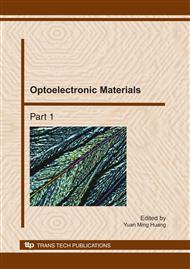p.506
p.511
p.515
p.519
p.523
p.527
p.532
p.538
p.542
The Effect of the Coating Layer and the Doped Ion Concentration on the Dielectric Properties of SiO2-PANI Electrorheological Fluid
Abstract:
The silicon dioxide particles are coated by polyaniline (PANI) under low temperature, and the doped ion concentration in PANI was adjusted by ammonia with different pH. The dielectric properties of PANI/SiO2 eletrorheological (ER) fluids are measured by impedance analyzer. The results indicated that the dielectric increment and relaxation frequency of ER fluid were enhanced after surface modification of SiO2, which are positive to the ER effect. Moreover, the pH of ammonia can change the relaxation frequency of ER fluid, which can improve the response ability of ER fluid to electric field.
Info:
Periodical:
Pages:
523-526
Citation:
Online since:
November 2010
Authors:
Price:
Сopyright:
© 2011 Trans Tech Publications Ltd. All Rights Reserved
Share:
Citation:


